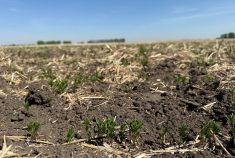Data compiled by a U.S. federal weather forecasting agency show La Nina conditions have developed over the central Pacific Ocean and are likely to linger through February.
And La Nina, in turn, is expected to produce hard cold snaps over the Prairies, above-normal precipitation over southern British Columbia and relatively mild temperatures with more snow over Ontario and Quebec, according to private forecasting agency AccuWeather.
The U.S. National Weather Service’s Climate Prediction Center on Oct. 14 reported La Nina — a weather phenomenon marked by unusually cold temperatures on the equatorial Pacific Ocean — had emerged over the past month.
Read Also

Prairie forecast: Winter temperatures moving in
After several weeks of mild weather across the Prairies, it looks like true winter conditions are finally set to arrive.
“Negative anomalies” have been observed at depth across most of the central and eastern Pacific Ocean over that time, the agency said.
It also puts the chance at 87 per cent that a “moderate-strength” La Nina will continue over the period from December this year through February 2022.
Forecasters’ consensus then calls for a return to ENSO (El Nino-Southern Oscillation)-neutral conditions during the March to May 2022 period, the agency said.
AccuWeather, in a separate release Oct. 14 including the company’s annual winter forecast for Canada, said this La Nina’s effect, particularly over Western Canada, will likely be temperatures falling “even lower than they do during the average winter.”
Noting last winter’s weather was also under the influence of a La Nina, the company said a polar jet stream “amplified” by La Nina conditions can again lead to colder air and more frequent storms.
“The upcoming winter is expected to be fairly stormy from southern British Columbia through the Canadian Rockies with many opportunities for significant rainfall and strong winds along the coast,” AccuWeather meteorologist Brett Anderson said.
“Abundant” snowfall is expected throughout much of B.C.’s Coastal Range through the Rockies in western Alberta, he said in the company’s release.
“Based on what I see, I think this winter will be wetter than the past five winters in southern British Columbia,” he said. “I think this winter will certainly put a dent in the ongoing severe drought across south-central parts of the province. Conditions have already improved across southwestern British Columbia this fall as drought conditions have almost disappeared.”
Further east, he said, the polar vortex could be displaced from its normal area above the North Pole and drop into the Prairie region from time to time. “I believe we may see at least three extreme blasts of bitterly cold air dropping down into the southern Prairies this winter,” with temperatures dropping below -30 C at those points.
“This winter will likely end up colder than the winter of 2018-2019 and the coldest winter since 2013-2014 in the region.”
Cold snaps across the Prairies this winter should also force a secondary storm track well far to the south in the U.S., Anderson said, and drive storms through the U.S. Rockies and southern Plains of the U.S., before swinging northward into Eastern Canada.
“The majority of the snowstorms will track up into Ontario and Quebec,” he said.
Further east, the company said, the storm track skewing north and west, combined with “very high” water temperatures in the northwest Atlantic Ocean, favours a milder winter with average snowfall in Atlantic Canada. — Glacier FarmMedia Network
















